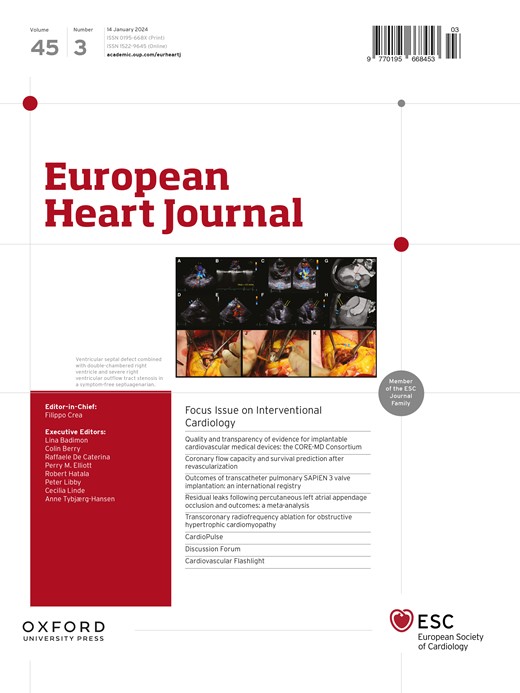Drug-coated vs non-drug-coated devices for femoropopliteal artery interventions: long-term outcomes of the SAFE-PAD study.
IF 35.6
1区 医学
Q1 CARDIAC & CARDIOVASCULAR SYSTEMS
引用次数: 0
Abstract
BACKGROUND AND AIMS Femoropopliteal artery disease is associated with high rates of post-revascularization restenosis. Drug-coated devices (DCD), including drug-coated balloons (DCBs) and drug-eluting stents (DES), have demonstrated efficacy in reducing restenosis rates compared to non-drug-coated devices (NDCDs). However, concerns about potential long-term mortality risks have led to regulatory scrutiny. This study represents the final report from the Safety Assessment of Femoropopliteal Endovascular Treatment with Paclitaxel-Coated Devices (SAFE-PAD) study, a pre-specified analysis designed with the US Food and Drug Administration to evaluate the long-term mortality associated with femoropopliteal DCD use. METHODS SAFE-PAD was a retrospective cohort study of 168 553 Medicare fee-for-service beneficiaries (≥66 years) who underwent femoropopliteal artery revascularization between 2015 and 2018. Device exposure (DCDs vs. NDCDs) was identified using Medicare claims data. The primary outcome was all-cause mortality, assessed between treatment groups using inverse probability treatment weighting. Secondary outcomes included all-cause hospitalizations, repeat revascularization, major amputation, and cardiovascular medication use. Sensitivity analyses included instrumental variable methods, falsification endpoints, and simulation of hypothetical unmeasured confounders. Subgroup analyses examined outcomes in inpatient vs outpatient settings, in younger/low-risk populations, and in high-risk chronic limb-threatening ischaemia patients. RESULTS At a median follow-up of 4.3 years (maximum: 9.0 years), DCD use was not associated with increased mortality (adjusted hazard ratio: 0.98; 95% confidence interval: 0.97, 0.99), meeting the pre-specified 5% non-inferiority relative margin. Sensitivity analyses supported the validity of the primary result. Secondary outcomes showed similar hospitalization and amputation rates between groups but an increase in repeat revascularization with DCDs. Subgroup analyses confirmed safety findings across high/low-risk subgroups and across clinical settings. CONCLUSIONS In this final report from the SAFE-PAD study, there was no evidence of long-term mortality risk associated with DCDs used for femoropopliteal revascularization. The SAFE-PAD study helped inform the reversal of regulatory warnings against routine DCD use.股腘动脉干预的药物包被与非药物包被装置:SAFE-PAD研究的长期结果
背景和目的股腘动脉疾病与血运重建术后再狭窄的高发率相关。药物包被装置(DCD),包括药物包被气球(DCBs)和药物洗脱支架(DES),与非药物包被装置(ndcd)相比,已经证明在降低再狭窄率方面有效。然而,对潜在长期死亡风险的担忧导致了监管审查。本研究代表了紫杉醇涂层装置(SAFE-PAD)股腘血管内治疗安全性评估研究的最终报告,该研究是美国食品和药物管理局设计的一项预先指定的分析,旨在评估与股腘血管内使用DCD相关的长期死亡率。方法safe - pad是一项回顾性队列研究,纳入了2015年至2018年间接受股腘动脉重建术的168553名医疗保险服务收费受益人(≥66岁)。使用医疗保险索赔数据确定设备暴露(dcd与ndcd)。主要结局是全因死亡率,使用反概率治疗加权法评估治疗组之间的死亡率。次要结局包括全因住院、重复血运重建术、主要截肢和心血管药物使用。敏感性分析包括工具变量方法、伪造终点和假设未测量混杂因素的模拟。亚组分析检查了住院患者与门诊患者、年轻/低风险人群和高风险慢性肢体威胁缺血性患者的预后。结果在中位随访4.3年(最长随访9.0年)中,DCD的使用与死亡率增加无关(校正风险比:0.98;95%可信区间:0.97,0.99),符合预先设定的5%非效性相对裕度。敏感性分析支持了主要结果的有效性。次要结果显示两组之间的住院率和截肢率相似,但dcd的重复血运重建率增加。亚组分析证实了高/低风险亚组和临床环境的安全性发现。在SAFE-PAD研究的最终报告中,没有证据表明dcd用于股腘血管重建术存在长期死亡风险。SAFE-PAD研究帮助逆转了常规使用DCD的监管警告。
本文章由计算机程序翻译,如有差异,请以英文原文为准。
求助全文
约1分钟内获得全文
求助全文
来源期刊

European Heart Journal
医学-心血管系统
CiteScore
39.30
自引率
6.90%
发文量
3942
审稿时长
1 months
期刊介绍:
The European Heart Journal is a renowned international journal that focuses on cardiovascular medicine. It is published weekly and is the official journal of the European Society of Cardiology. This peer-reviewed journal is committed to publishing high-quality clinical and scientific material pertaining to all aspects of cardiovascular medicine. It covers a diverse range of topics including research findings, technical evaluations, and reviews. Moreover, the journal serves as a platform for the exchange of information and discussions on various aspects of cardiovascular medicine, including educational matters.
In addition to original papers on cardiovascular medicine and surgery, the European Heart Journal also presents reviews, clinical perspectives, ESC Guidelines, and editorial articles that highlight recent advancements in cardiology. Additionally, the journal actively encourages readers to share their thoughts and opinions through correspondence.
 求助内容:
求助内容: 应助结果提醒方式:
应助结果提醒方式:


